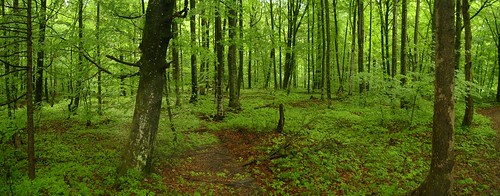Biomass Power In Austria
Posted by Big Gav in austria, biogas, biomass
Dave Roberts has come back from a trip to Austria brimming with enthusiasm about the human-scale, renewable, domestic power systems reviving rural Austrian economies that he discovered.
On a sunny Saturday afternoon in Salzburg, we took a field trip to a few examples of biomass in rural Austria. The country is over 40 percent forested, and over half of the forest is owned by small farmers with less than 40 hectares (just under 100 acres), so the government has put a priority on encouraging biomass use as a substitute for fossil fuels. It's a stable domestic industry, carefully managed with an eye toward local economic development and, as with just about everything I laid eyes on in Austria, proper aesthetics.
The first place we stopped was a biomass district heating co-op run by 18 farmers. To the right is the enormous pile of wood chips we saw in a huge, beautifully wrought barn.
The chips are continuously and automatically fed into the hyper-efficient furnace to the left, where they are burned at high temperatures. The combustion heats water, which is then fed through a network of pipes underneath the village. A system of heat exchangers uses the water to heat each house.
Obviously the farmers make more money during the cold winters, but the co-op provides a stable, predictable supplemental income throughout the year.
The next place we visited was a biomass digester. Instead of burning pure wood, it feeds a mixture of wood, straw, and godknowswhat from that yellow bin in front (it was stinky!) into the huge tank to the left, where it ferments. The gases released by the fermentation are captured, fed into the building to the far right (not quite visible), and burned to create electricity, which is fed into the grid. The leftover sludgy stuff is distributed as mulch. The hot air created by the generator is piped into a building next door and used to dry wood chips, which are then shredded and used to make compact wood pellets.
Delightful! Both these facilities were so ... I don't want to say low-tech. Analog. They were like fantastic Rube Goldberg machines, squeezing every bit of useful energy out of local, renewable material. This stuff is heavily subsidized by the government, but it has helped (along with tourism) revive several local economies.
Let's keep going! ...
I was taken aback. There was no heat coming off it at all, no noise, not so much as a vibration. But he opened the gray door and sure enough, there was another porthole through which we could see dancing flames.
I came away from the day utterly charmed and impressed. Like so little in day-to-day American life, these systems are simple, resilient, and predictable, locally owned and run, and of appropriate scale and character. They fit.






